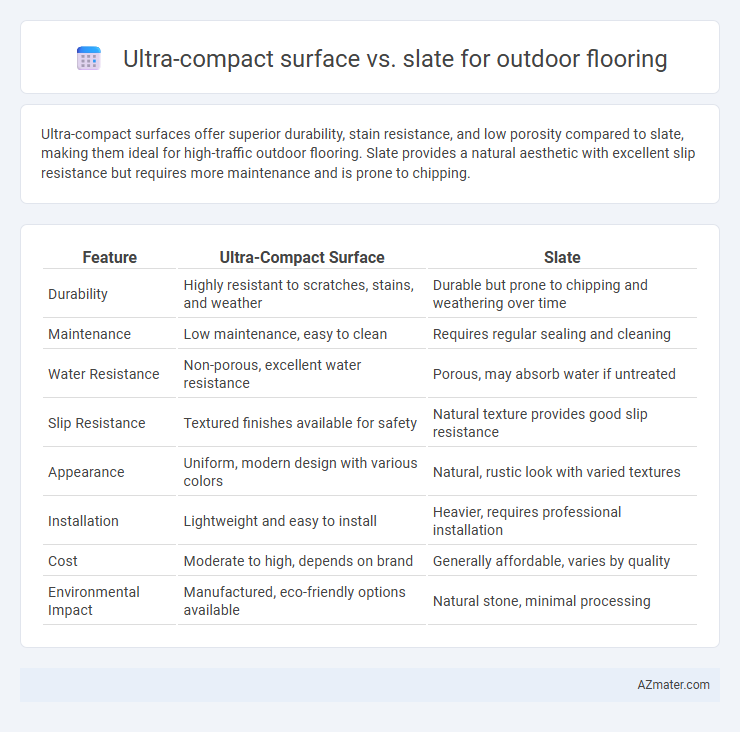Ultra-compact surfaces offer superior durability, stain resistance, and low porosity compared to slate, making them ideal for high-traffic outdoor flooring. Slate provides a natural aesthetic with excellent slip resistance but requires more maintenance and is prone to chipping.
Table of Comparison
| Feature | Ultra-Compact Surface | Slate |
|---|---|---|
| Durability | Highly resistant to scratches, stains, and weather | Durable but prone to chipping and weathering over time |
| Maintenance | Low maintenance, easy to clean | Requires regular sealing and cleaning |
| Water Resistance | Non-porous, excellent water resistance | Porous, may absorb water if untreated |
| Slip Resistance | Textured finishes available for safety | Natural texture provides good slip resistance |
| Appearance | Uniform, modern design with various colors | Natural, rustic look with varied textures |
| Installation | Lightweight and easy to install | Heavier, requires professional installation |
| Cost | Moderate to high, depends on brand | Generally affordable, varies by quality |
| Environmental Impact | Manufactured, eco-friendly options available | Natural stone, minimal processing |
Introduction to Outdoor Flooring Options
Ultra-compact surfaces and slate are popular choices for outdoor flooring due to their durability and aesthetic appeal. Ultra-compact surfaces provide resistance to weather, stains, and scratches with low maintenance requirements, making them ideal for high-traffic outdoor areas. Slate offers a natural, textured look with excellent slip resistance and longevity, enhancing outdoor spaces with its timeless elegance and robustness.
What is Ultra-Compact Surface?
Ultra-compact surfaces are advanced engineered materials composed of natural minerals fused under extreme pressure and high temperature, resulting in a highly durable, non-porous, and scratch-resistant surface ideal for outdoor flooring. Unlike traditional slate, ultra-compact surfaces offer superior resistance to weathering, stains, and UV exposure, ensuring long-lasting aesthetics and minimal maintenance. Their lightweight yet robust structure also allows for easier installation and greater design flexibility in outdoor environments.
Understanding Slate as a Flooring Material
Slate, a natural metamorphic rock, offers exceptional durability and slip resistance, making it a popular choice for outdoor flooring. Its unique layered texture and natural color variations provide a visually appealing, non-porous surface ideal for withstanding harsh weather conditions. Compared to ultra-compact surfaces, slate requires more maintenance but delivers a timeless, authentic aesthetic with excellent thermal insulation properties.
Durability: Ultra-Compact Surface vs Slate
Ultra-compact surfaces exhibit exceptional durability for outdoor flooring due to their resistance to scratches, stains, and UV rays, maintaining appearance in harsh weather conditions. Slate, a natural stone, is durable but prone to chipping and requires sealing to protect against moisture and temperature variations. The ultra-compact surface generally outperforms slate in long-term maintenance and weather resilience, making it ideal for high-traffic outdoor areas.
Weather Resistance in Outdoor Environments
Ultra-compact surfaces offer superior weather resistance for outdoor flooring, with high density and low porosity that prevent water absorption, frost damage, and UV degradation, making them ideal for harsh climates. Slate, while naturally durable and resistant to temperature fluctuations, can be more prone to chipping and requires sealing to enhance its weatherproof properties. Choosing ultra-compact surfaces ensures longer-lasting performance and minimal maintenance in outdoor environments exposed to rain, snow, and intense sunlight.
Aesthetics and Design Flexibility
Ultra-compact surfaces offer sleek, uniform aesthetics with a vast range of colors and textures, providing exceptional design flexibility for outdoor flooring. Slate exudes natural elegance with unique, irregular patterns and rich, earthy tones, lending a timeless, organic appeal that enhances landscape visuals. The ultra-compact surface supports minimalist, contemporary styles, while slate complements rustic or traditional designs, catering to diverse aesthetic preferences.
Installation Process and Maintenance
Ultra-compact surfaces for outdoor flooring offer a streamlined installation process due to their lightweight and thin profile, often requiring minimal substrate preparation and allowing rapid placement with mechanical fixing or adhesive. Slate, known for its natural durability, involves a more labor-intensive installation, including careful cutting, leveling, and anchoring to ensure stability and prevent cracking. Maintenance of ultra-compact surfaces is generally low, with high resistance to stains, scratches, and weather, while slate requires periodic sealing to maintain its appearance and protect against moisture and algae buildup.
Cost Comparison: Ultra-Compact Surface vs Slate
Ultra-compact surfaces typically cost between $50 to $120 per square foot, offering a modern, durable, and low-maintenance option for outdoor flooring. Slate prices range from $8 to $15 per square foot but can incur higher installation and maintenance expenses due to its natural variability and susceptibility to weathering. When factoring in long-term durability and upkeep, ultra-compact surfaces may offer a more cost-effective solution despite their higher initial price.
Eco-Friendliness and Sustainability
Ultra-compact surfaces for outdoor flooring offer superior eco-friendliness due to their low water absorption rate and long lifespan, reducing the need for frequent replacements. Slate, a natural stone, is durable and recyclable but requires energy-intensive quarrying and transportation, contributing to a larger carbon footprint. Choosing ultra-compact surfaces made from recycled materials enhances sustainability by minimizing resource depletion and promoting circular economy practices.
Choosing the Best Outdoor Flooring for Your Space
Ultra-compact surfaces offer exceptional durability, resistance to stains, scratches, and weather conditions, making them ideal for high-traffic outdoor areas. Slate provides a natural, textured aesthetic with excellent slip resistance but requires regular sealing to prevent weather damage and maintain longevity. Selecting the best outdoor flooring depends on balancing ultra-compact surface's low maintenance and robust performance against slate's organic beauty and traditional appeal.

Infographic: Ultra-compact surface vs Slate for Outdoor flooring
 azmater.com
azmater.com